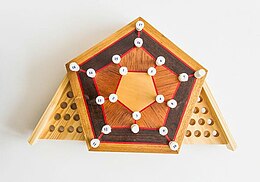The icosian game is a mathematical game invented in 1856 by Irish mathematician William Rowan Hamilton. It involves finding a Hamiltonian cycle on a dodecahedron, a cycle using edges of the dodecahedron that passes through all its vertices. Hamilton sold his work to a game manufacturing company, but it was not commercially successful. Although Hamilton was not the first to study Hamiltonian cycles, his work on this game became the origin of the name of Hamiltonian cycles.

Game play
The game's object is to find a cycle among along the edges of a regular dodecahedron, returning to its starting vertex after visiting each vertex a single time. (A cycle visiting all vertices in this way is now called a Hamiltonian cycle.) In a two-player version of the game, one player starts by choosing five consecutive vertices along the cycle, and the other player must complete the cycle.
One version of the game took the form of a flat wooden board inscribed with a planar graph with the same combinatorial structure as the dodecahedron (a Schlegel diagram), with holes for numbered pegs to be placed at its vertices. The cycle found by game players was indicated by the consecutive numbering of the pegs. Another version was shaped as a "partially flattened dodecahedron" with a handle attached to its base. The vertices had fixed pegs. A separate string, with a loop at one end, was wound through these pegs to indicate the cycle.
The game was too easy to play to achieve much popularity.
Background
At the time of his invention of the icosian game, William Rowan Hamilton was the Andrews Professor of Astronomy at Trinity College Dublin and Royal Astronomer of Ireland, and was already famous for his work on Hamiltonian mechanics and his invention of quaternions. The motivation for Hamilton was the problem of understanding the symmetries of the dodecahedron and icosahedron, two dual polyhedra that have the same symmetries as each other. For this purpose he also invented icosian calculus, a system of non-commutative algebra which he used to compute these symmetries.
The name of the icosian game comes from the fact that the icosahedron has twenty faces, the dodecahedron has twenty vertices, and any cycle through all the vertices of the dodecahedron has twenty edges. Icosa is a Greek root meaning twenty. On a dodecahedron with labeled vertices, there are 30 different ways that these vertices could be connected to each other to form a Hamiltonian cycle. However, without the labels, the resulting cycles are all symmetric to each other under rotations and reflections of the dodecahedron.
History
Both the icosian calculus and the icosian game were outlined by Hamilton in a series of letters to his friend John T. Graves in late 1856. Hamilton then exhibited the game at the 1857 Dublin meeting of the British Association for the Advancement of Science. At the suggestion of Graves, Hamilton sold its publishing rights to Jaques and Son, a London-based toy and game manufacturing company.
This company marketed Hamilton's game beginning in 1859, in both its handheld solid and flat forms, under the lengthy titles The Travellers Dodecahedron, or a voyage around the world, and (respectively) The Icosian Game, invented by Sir William Rowan Hamilton, Royal Astronomer of Ireland; forming a new and highly amusing game for the drawing room, particularly interesting to students in mathematics of illustrating the principles of the Icosian Calculus.
Several other versions of the game were sold in Europe. However, it was not a commercial success. Hamilton received only a £25 licensing fee from Jaques and Son for his invention. Few original copies of the game are known to survive, but one is kept in the library of the Royal Irish Academy in Dublin, and another is included in the collection of the Conservatoire national des arts et métiers in Paris.
Legacy
Although Hamilton invented the icosian game independenly, he was not the first to study Hamiltonian cycles. Knight's tours on chessboards, another puzzle based on Hamiltonian cycles, go back to the 9th century, both in India and in mathematics in the medieval Islamic world. At about the same time as Hamilton, Thomas Kirkman in England was also studying Hamiltonian cycles on polyhedra. Hamilton visited Kirkman in 1861, and presented him with a copy of the icosian game. Despite this related work, some of which was much earlier, Hamiltonian cycles came to be named for Hamilton and for his work on the icosian game.
The icosian game itself has been the topic of multiple works in recreational mathematics by well-known authors on the subject including Édouard Lucas, Wilhelm Ahrens, and Martin Gardner. Puzzles like Hamilton's icosian game, based on finding Hamiltonian cycles in planar graphs, continue to be sold as smartphone apps. Additionally, Maker-Breaker games based on Hamiltonian cycles continue to be an object of study in modern combinatorial game theory.
See also
- Hunt the Wumpus, another game played on the graph of a dodecahedron
- Seven Bridges of Königsberg, a puzzle of finding a cycle through all edges of a graph
References
Further reading
- Antonick, Gary (6 October 2014), "Hamilton's Icosian Game", The New York Times, including an interactive solver for finding Hamiltonian paths on a dodecahedron
- Weisstein, Eric W., "Icosian game", MathWorld, showing the 30 solutions on the planar board